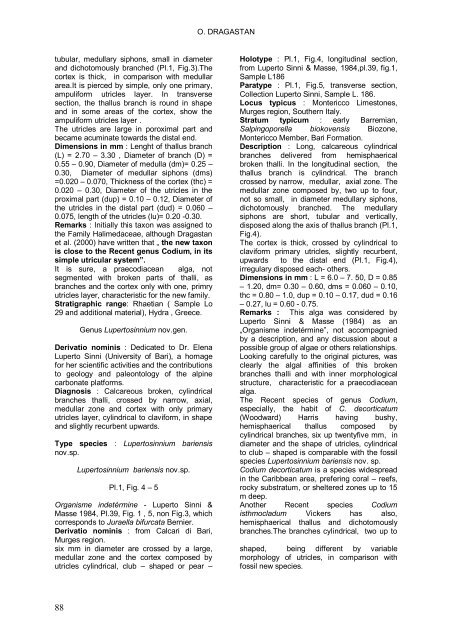mesozoic and cenozoic calcareous algae, praecursors of family
mesozoic and cenozoic calcareous algae, praecursors of family
mesozoic and cenozoic calcareous algae, praecursors of family
You also want an ePaper? Increase the reach of your titles
YUMPU automatically turns print PDFs into web optimized ePapers that Google loves.
O. DRAGASTAN<br />
tubular, medullary siphons, small in diameter<br />
<strong>and</strong> dichotomously branched (Pl.1, Fig.3).The<br />
cortex is thick, in comparison with medullar<br />
area.It is pierced by simple, only one primary,<br />
ampuliform utricles layer. In transverse<br />
section, the thallus branch is round in shape<br />
<strong>and</strong> in some areas <strong>of</strong> the cortex, show the<br />
ampuliform utricles layer .<br />
The utricles are large in poroximal part <strong>and</strong><br />
became acuminate towards the distal end.<br />
Dimensions in mm : Lenght <strong>of</strong> thallus branch<br />
(L) = 2.70 – 3.30 , Diameter <strong>of</strong> branch (D) =<br />
0.55 – 0.90, Diameter <strong>of</strong> medulla (dm)= 0.25 –<br />
0.30, Diameter <strong>of</strong> medullar siphons (dms)<br />
=0.020 – 0.070, Thickness <strong>of</strong> the cortex (thc) =<br />
0.020 – 0.30, Diameter <strong>of</strong> the utricles in the<br />
proximal part (dup) = 0.10 – 0.12, Diameter <strong>of</strong><br />
the utricles in the distal part (dud) = 0.060 –<br />
0.075, length <strong>of</strong> the utricles (lu)= 0.20 -0.30.<br />
Remarks : Initially this taxon was assigned to<br />
the Family Halimedaceae, although Dragastan<br />
et al. (2000) have written that „ the new taxon<br />
is close to the Recent genus Codium, in its<br />
simple utricular system”.<br />
It is sure, a praecodiacean alga, not<br />
segmented with broken parts <strong>of</strong> thalli, as<br />
branches <strong>and</strong> the cortex only with one, primry<br />
utricles layer, characteristic for the new <strong>family</strong>.<br />
Stratigraphic range: Rhaetian ( Sample Lo<br />
29 <strong>and</strong> additional material), Hydra , Greece.<br />
Genus Lupertosinnium nov.gen.<br />
Derivatio nominis : Dedicated to Dr. Elena<br />
Luperto Sinni (University <strong>of</strong> Bari), a homage<br />
for her scientific activities <strong>and</strong> the contributions<br />
to geology <strong>and</strong> paleontology <strong>of</strong> the alpine<br />
carbonate platforms.<br />
Diagnosis : Calcareous broken, cylindrical<br />
branches thalli, crossed by narrow, axial,<br />
medullar zone <strong>and</strong> cortex with only primary<br />
utricles layer, cylindrical to claviform, in shape<br />
<strong>and</strong> slightly recurbent upwards.<br />
Type species : Lupertosinnium bariensis<br />
nov.sp.<br />
Lupertosinnium bariensis nov.sp.<br />
Pl.1, Fig. 4 – 5<br />
Organisme indetérmine - Luperto Sinni &<br />
Masse 1984, Pl.39, Fig. 1 , 5, non Fig.3, which<br />
corresponds to Juraella bifurcata Bernier.<br />
Derivatio nominis : from Calcari di Bari,<br />
Murges region.<br />
six mm in diameter are crossed by a large,<br />
medullar zone <strong>and</strong> the cortex composed by<br />
utricles cylindrical, club – shaped or pear –<br />
Holotype : Pl.1, Fig.4, longitudinal section,<br />
from Luperto Sinni & Masse, 1984,pl.39, fig.1,<br />
Sample L186<br />
Paratype : Pl.1, Fig.5, transverse section,<br />
Collection Luperto Sinni, Sample L. 186.<br />
Locus typicus : Montericco Limestones,<br />
Murges region, Southern Italy.<br />
Stratum typicum : early Barremian,<br />
Salpingoporella biokovensis Biozone,<br />
Montericco Member, Bari Formation.<br />
Description : Long, <strong>calcareous</strong> cylindrical<br />
branches delivered from hemisphaerical<br />
broken thalli. In the longitudinal section, the<br />
thallus branch is cylindrical. The branch<br />
crossed by narrow, medullar, axial zone. The<br />
medullar zone composed by, two up to four,<br />
not so small, in diameter medullary siphons,<br />
dichotomously branched. The medullary<br />
siphons are short, tubular <strong>and</strong> vertically,<br />
disposed along the axis <strong>of</strong> thallus branch (Pl.1,<br />
Fig.4).<br />
The cortex is thick, crossed by cylindrical to<br />
claviform primary utricles, slightly recurbent,<br />
upwards to the distal end (Pl.1, Fig.4),<br />
irregulary disposed each- others.<br />
Dimensions in mm : L = 6.0 – 7. 50, D = 0.85<br />
– 1.20, dm= 0.30 – 0.60, dms = 0.060 – 0.10,<br />
thc = 0.80 – 1.0, dup = 0.10 – 0.17, dud = 0.16<br />
– 0.27, lu = 0.60 - 0.75.<br />
Remarks : This alga was considered by<br />
Luperto Sinni & Masse (1984) as an<br />
„Organisme indetérmine”, not accompagnied<br />
by a description, <strong>and</strong> any discussion about a<br />
possible group <strong>of</strong> <strong>algae</strong> or others relationships.<br />
Looking carefully to the original pictures, was<br />
clearly the algal affinities <strong>of</strong> this broken<br />
branches thalli <strong>and</strong> with inner morphological<br />
structure, characteristic for a praecodiacean<br />
alga.<br />
The Recent species <strong>of</strong> genus Codium,<br />
especially, the habit <strong>of</strong> C. decorticatum<br />
(Woodward) Harris having bushy,<br />
hemisphaerical thallus composed by<br />
cylindrical branches, six up twentyfive mm, in<br />
diameter <strong>and</strong> the shape <strong>of</strong> utricles, cylindrical<br />
to club – shaped is comparable with the fossil<br />
species Lupertosinnium bariensis nov. sp.<br />
Codium decorticatum is a species widespread<br />
in the Caribbean area, prefering coral – reefs,<br />
rocky substratum, or sheltered zones up to 15<br />
m deep.<br />
Another Recent species Codium<br />
isthmocladum Vickers has also,<br />
hemisphaerical thallus <strong>and</strong> dichotomously<br />
branches.The branches cylindrical, two up to<br />
shaped, being different by variable<br />
morphology <strong>of</strong> utricles, in comparison with<br />
fossil new species.<br />
88

















